Colour-rings and radio-tracking are helping to chart the ongoing decline of the Dutch Black-tailed Godwit population.

A Portuguese rice field, full of limosa Black-tailed Godwits; most are Dutch breeders
The Black-tailed Godwit is the national bird of the Netherlands, the country in which the vast majority of the West European limosa race breed. These Dutch birds are an important part of the country’s cultural heritage and are of major international significance. Large amounts of money have gone into supporting the species, and the meadows that they share with others such as Redshank and Snipe, but efforts so far have failed to reverse a Black-tailed Godwit decline that has been going on since at least the 1970s. This negative situation is in stark contrast to the increases seen in the islandica subspecies that breeds in Iceland and winters in countries between Scotland and Spain. (There’s a comparison of the two subspecies in this WaderTales blog)
Counting Black-tailed Godwits
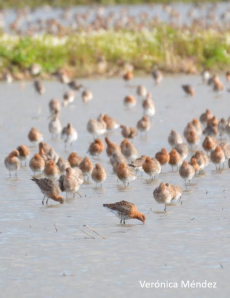 It is often easier to measure changes in numbers of waders on the wintering grounds, when birds are in flocks, than when pairs are thinly spread across their breeding ranges. For Dutch Black-tailed Godwits, most of which spend the winter in African countries, south and west of the Sahara, however, the best opportunity to monitor population trends occurs in Spain and Portugal in February, when the birds are on their way back to breed.
It is often easier to measure changes in numbers of waders on the wintering grounds, when birds are in flocks, than when pairs are thinly spread across their breeding ranges. For Dutch Black-tailed Godwits, most of which spend the winter in African countries, south and west of the Sahara, however, the best opportunity to monitor population trends occurs in Spain and Portugal in February, when the birds are on their way back to breed.
Each year a small group of ornithologists visit key sites in Extremadura, the Doñana Wetlands and the rice fields of the Tagus Estuary, to count flocks of birds and to look for colour-ringed birds. They’re able to use these counts and sightings of colour-ringed birds to assess what has happened to numbers in the previous twelve months.

grutto met ringen (ringed Black-tailed Godwit)
In three of the years since 2007 they’ve witnessed increases but in most years the numbers have gone down. As February 2017 approaches, what will this year’s score be? How many of last year’s birds will have died and how many chicks hatched in 2015 and 2016 will be making the migratory journey north for the first time?
When assessing how many breeding godwits there are in the Netherlands the researchers collect and use the following information:
- Counts of birds seen in flocks in Spain and Portugal.
-
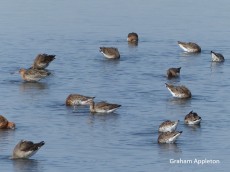
It’s not always easy to see the colour-rings in rice fields
Counts of colour-ringed birds. There’s a great one-line comment in the newly-published paper that forms the basis of this blog: ‘In total, we checked 420,206 godwits for colour-rings at Spanish and Portuguese staging sites’. That’s a lot of legs – and a huge effort.
- An assessment of the proportion of islandica Black-tailed godwits in the flocks, so that they can be removed from the estimation process. This proportion had been established previously but were also monitored using sightings of colour-ringed birds of the islandica and limosa subspecies, and by taking account of the proportion of each population that wears rings.
-

Rosemarie Kentie in the rice fields of the Tagus estuary (Portugal)
An estimate of the number of the birds that will be flying north to the Netherlands, as opposed to other countries. Limosa Black-tailed Godwits that pass through Iberia are on their way to a range of countries, stretching from the tiny population that breed in the UK, in the Ouse and Nene Washes, across to Germany in the east. This proportion was calculated by monitoring the movements of satellite-tagged individuals.
The results were published in a recent paper, which also presents annual survival rates, obtained using colour-ring sightings. There is a full explanation of the methodology in the paper. You can also see maps from the satellite-tagging project on the King of the Meadows website.
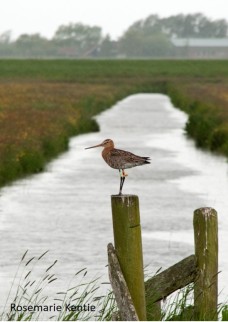 Estimating the size of the Dutch breeding population of Continental Black-tailed Godwits from 2007–2015 using resighting data from spring staging sites. Ardea 114: 213–225. doi:10.5253/arde.v104i3.a7
Estimating the size of the Dutch breeding population of Continental Black-tailed Godwits from 2007–2015 using resighting data from spring staging sites. Ardea 114: 213–225. doi:10.5253/arde.v104i3.a7
The authors are Rosemarie Kentie, Nathan R. Senner, Jos C.E.W. Hooijmeijer, Rocío Márquez-Ferrando, Jordi Figuerola, José A. Masero, Mo A. Verhoeven & Theunis Piersma.
Latest findings
Over the eight years of the survey work, the average decline in numbers of limosa Black-tailed Godwits has been 3.7% per year. Numbers appeared to go up between 2009 and 2011, when the calculated survival rate of young birds was high, but the magnitude of this perceived recovery may have been artificially elevated by an increase in the number of Icelandic birds. From WeBS counts in the United Kingdom, the number of islandica birds is continuing to rise.
Since 2011, the estimated annual decrease has been 6.3% per year. Such large declines can only occur if there is both low recruitment and reduced adult survival.
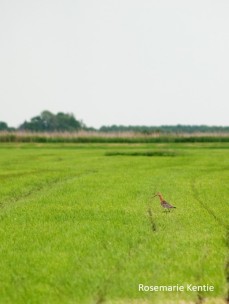
Agricultural intensification has seriously affected Dutch Black-tailed Godwits
The estimated breeding population in the Netherlands in 2015 was 33,000 pairs, representing a drop of nearly 75% since 1967. However, the agricultural grasslands of the Netherlands are still the single most important stronghold for breeding limosa Black-tailed Godwits using the East Atlantic flyway.
The authors finish with a sad conclusion. “Although enormous amounts of money and effort have been expended to conserve continental godwits, our findings make clear that these have been ineffective or insufficient.”
One wonders how much worse the situation would have been without Dutch and European support for Meadow Birds and the ‘King of the Meadows’ in particular?
The authors are Rosemarie Kentie, Nathan R. Senner, Jos C.E.W. Hooijmeijer, Rocío Márquez-Ferrando, Jordi Figuerola, José A. Masero, Mo A. Verhoeven & Theunis Piersma.
WaderTales blogs are written by Graham Appleton, to celebrate waders and wader research. Many of the articles are based on previously published papers, with the aim of making wader science available to a broader audience.
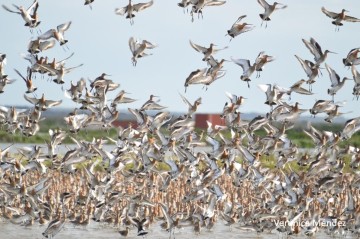

Hello Graham, first of all I want to say this is a great blog with a lot of interesting articles especially for wader-enthusiasts. I’m organizing a project in the middle east about the migration routes of the eastern population of Black-tailed Godwits and I think this would fit very nice to your blog. So If you are interested in publish an article or two about it please contact me.
Best regards
Christoph
LikeLike
Thanks for the kind comments, Christoph. Thus far, the blogs have been linked to papers but I am open to suggestions.
LikeLike
I love them all but Godwit is the real exclusive one.Thank for sharing your great article.
Ileana
LikeLike
This is really interesting – thanks Graham. But I was wondering (in ignorance because I can’t access the paper and, of course, not being a Black-tailed Godwitologist) how they cope with all the uncertainties. I would have thought the biggest one being whether the birds from Netherlands are still all using Portugal and whether the proportions assumed from the other breeding populations have remained constant over time (or if they change, how they assess the change). Migrant waders are good at changing where they winter – and with climate change, there might be some interesting changes that aren’t taken into account in their estimates.
Is there no way they can actually do a breeding season count to validate their proxy measures?
Worrying picture, if the numbers are correct though.
Cheers
Humphrey
LikeLike
Glad you liked it. The population estimates are calculated from proportions of colour ringed birds, taking account of resighting probabilities. Jen and the gang did the same with Icelandic godwits a few year ago – the very high resighting rates in winter flocks of waders generally make this the most robust method. The problem with breeding season counts is that the proportion of birds breeding and the proportion failing prior to the counts are unknown and, of course, birds are thinly spread over large areas of meadowland. Counts made in well-studied breeding populations are consistent with information garnered in Spain & Portugal.
LikeLike
Pingback: Do Iceland’s farmers care about wader conservation? | wadertales
Pingback: Why are we losing our large waders? | wadertales
Pingback: Should Black-tailed Godwits cross the Sahara? | wadertales
Pingback: Special Black-tailed Godwits | wadertales
Pingback: Which wader, when and why? | wadertales
Pingback: Black-tailed Godwits expand their range in Russia and Iceland | wadertales
Pingback: International Shorebird Rescue | wadertales
Pingback: WaderTales blogs in 2017 | wadertales
Pingback: Site-fidelity in Black-tailed Godwits | wadertales
Pingback: Black-tailed Godwit and Curlew in France | wadertales
Pingback: Head-starting success | wadertales
Reblogged this on Wolf's Birding and Bonsai Blog.
LikeLike
Pingback: Tagus estuary: for birds or planes? | wadertales
Pingback: Nine red-listed UK waders | wadertales
Pingback: Black-tailed Godwits are on their way home | wadertales
Pingback: England’s Black-tailed Godwits | wadertales
Pingback: Subspecies, connectivity and conservation in shorebirds | wadertales
Pingback: Eleven waders on UK Red List | wadertales
Pingback: UK waders: “Into the Red” | wadertales
Pingback: Inland feeding by coastal godwits | wadertales